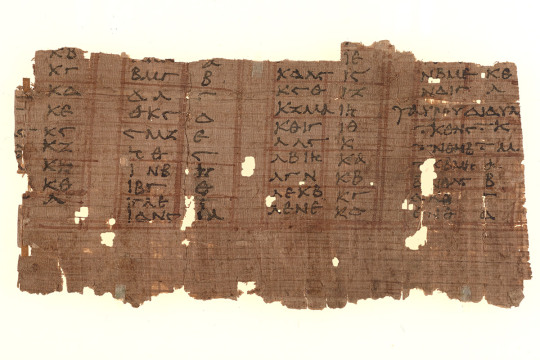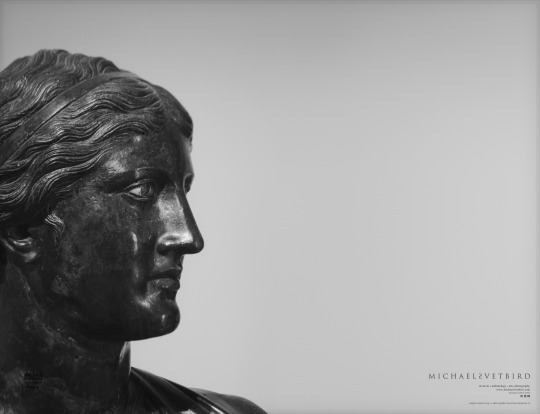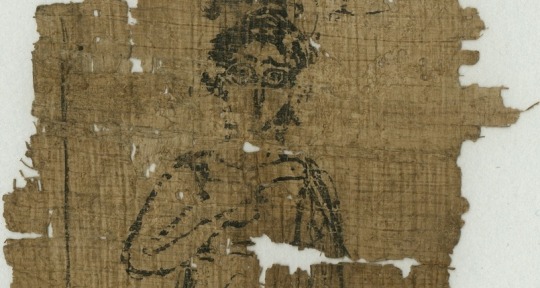#papyri
Text

~ Literary Papyri: Cyril of Alexandria, On Adoration and Worship in Spirit and in Truth.
Date: A.D. 550-614
Period: Byzantine
Place of origin: El-Deir (Fayoum, Egypt) (?)
#history#museum#archeology#archaeology#papyri#byzantium#byzantine#Cyril of Alexandria#Egyptian#Egypt#a.d. 550 b.c.#a.d. 614
549 notes
·
View notes
Text
The Vesuvius eruption may have destroyed Herculaneum, but it also preserved it. The site is a treasure trove of wooden artifacts rarely preserved from antiquity.
26 notes
·
View notes
Text
Truly I feel a bit unhinged about the Herculaneum like a child a week before Christmas. What's in those boxes what's under the tree will it be everything I've ever dreamed of or things I never knew I wanted or tangerines and will those tangerines contain new pits and slices unlike the ones we have now please I want to knowwwww
#herculaneum#papyri#taking me back to the 2014 new Sappho poem discovery but potentially unlimited#I'm weeping I'm shaking I'm waiting for the inevitable#( quitting my job the moment they discover Ovid's Medea )
20 notes
·
View notes
Text
I'm really enjoying these British Museum blogs about their artefacts. And on some level, I feel awfully guilty about enjoying them, given the source. But I do find them fascinating.
55 notes
·
View notes
Text

Fragment from Papyrus Oxyrhynchus 3376 (Egypt, 2nd century CE), containing portions of Book II (on Egypt) of Herodotus' Histories.
Source: http://www.papyrology.ox.ac.uk/cgi-bin/library?e=d-000-00---0POxy--00-0-0--0prompt-10---4------0-1l--1-en-50---20-help---00031-001-1-0utfZz-8-00&a=d&c=POxy&cl=CL5.1.33&d=HASH016fb6eb393e10a490f6f0bc
See also on these fragments http://faculty.washington.edu/garmar/POxy3376_Herodotus.pdf
10 notes
·
View notes
Text
New Exhibit and Opening | Early Astronomy in the University of Michigan Collections





We’re pleased to announce a new exhibit featuring a selection of manuscripts, early printed books, and artifacts illustrating Mesopotamian, Greek, Islamic, and Western European astronomies. Thes exhibit and its permanent online counterpart are part of The Aratus Project, which was sponsored by the National Science Foundation and led by professor Francesca Schironi. The core of the project has been to study Aratus’ "Phaenomena," the most important poem on stars and constellations of the Graeco-Roman ancient world, and its exegetical tradition. The physical and online exhibits place this research work within its later intellectual and historical context.
Join the curators this Thursday, 12 January, 4-6 pm in the Hatcher Gallery for a reception celebrating the opening of the exhibit followed by an exhibit tour!
Early Astronomy in the University of Michigan Collections is on display in the Hatcher Gallery Exhibit Room (1st floor, Hatcher Graduate Library) until 15 May 2023
Read more!
#exhibitions#exhibits#Exhibit Opening#events#libraries#archives#libraries and archives#special collections#special collections libraries#special collections and archives#manuscripts#illuminated manuscripts#early printed books#tablets#papyri#Papyrology Collection#kelsey museum#Islamic Manuscripts#History of Astronomy
34 notes
·
View notes
Text

SAPPHO | Σαπφώ
Bronze Bust of Sappho from Villa of the Papyri, Herculaneum
[https://en.wikipedia.org/wiki/Villa_of_the_Papyri]
1st c. BC Roman copy of the 2nd BC Greek original.
Museo Archeologico Nazionale di Napoli | MANN
[2nd Floor]
• Web : https://mann-napoli.it/en/home-english
• FB: https://www.facebook.com/MANNapoli
• IG: @museoarcheologiconapoli
• X: @MANNapoli
MANN | Michael Svetbird ph©msp | 19|23 6000X4600 600 [Closeup]
The photographed object is collection item of MANN, photo is subject to copyrights
[non commercial use | sorry for the watermarks]
📸 Part of the "PROFILE Shots" MSP Online Photo-gallery:
👉 D-ART:
https://www.deviantart.com/svetbird1234/gallery/89669842/profile-shots
👉 PINTEREST:
https://www.pinterest.com/Michael_Svetbird/profile-shots
👉 FB Album:
https://www.facebook.com/media/set/?set=a.2017689605266273&type=3
.
#naples#mann#archaeological museum#ancient sculpture#papyri#herculaneum#ancient art#roman sculpture#greek sculpture#sculpture#antiquity#ancient#archaeology#museology#heritage#art history#culture#sappho#σαπφώ#ancient rome#ancient world#women in history#photo gallery#profile#sculpture photography#art photography#archaeology photography#museum photography#michaelsvetbird
2 notes
·
View notes
Text
So fabulous! This technology is growing so fast right now! There are so many scrolls and documents that we’ve been waiting centuries to read. Finally our patience and conservators’ forbearance will pay off.
I’m a paper conservator and usually I want to physically treat everything, use my excellent fine skills of repair. But sometimes I have to tell myself to leave something alone to wait for future conservators who will have better science available to them.
2 notes
·
View notes
Text
HOLY SHIT THEY CAN READ THE PAPYRI FROM HERCULANEUM
1 note
·
View note
Text
THEY FUCKING DID IT!!!!!!!!!!!!

#tagamemnon#villa of the papyri#it is. seemingly more philodemus#but like. who cares about philodemus they have a method of digitally unwrapping + reading 2000 year old carbonised papyri#holy SHIT!!!!!!!!!!!!!!!!!!!!!!!!#beeps
14K notes
·
View notes
Text
The Herculaneum papyri, ancient scrolls housed in the library of a private villa near Pompeii, were buried and carbonized by the eruption of Vesuvius in 79 AD. For almost 2,000 years, this lone surviving library from antiquity was buried underground under 20 meters of volcanic mud. In the 1700s, they were excavated, and while they were in some ways preserved by the eruption, they were so fragile that they would turn to dust if mishandled. How do you read a scroll you can’t open? For hundreds of years, this question went unanswered.
That is until Luke Farritor, a contestant of the Vesuvius Challenge, became the first person in two millennia to see an entire word from within an unopened scroll this August. For that, we are thrilled to award Luke a $40,000 First Letters Prize, which required contestants to find at least 10 letters in a 4 cm2 area in a scroll.
0 notes
Text
A 21-year-old prodigy used AI to decode the unreadable text of a carbonized scroll from Herculaneum, potentially unlocking more ancient texts from a preserved Greco-Roman library.
38 notes
·
View notes
Text
Is it just me, or does the name Oxyrhynchus sound like a strong prescription drug you'd take for an acute stuffy nose? (P. Oxy 2652)

1 note
·
View note
Text
what if we went on a date to the museum and you allowed me to info dump about ancient egypt for four hours? what then?
668 notes
·
View notes
Text
Found a new Greek word: ἀνειδωλόπληκτος (anedoloplektos). It means "not afflicted by ghosts." here, i'll use it in a sentence.
"DNI unless you're anedoloplektos"
#i have NO idea what the text LSJ cites for usage is#it's PMag???#NEVER MIND tags cancelled it's magical papyri#i think.
1K notes
·
View notes
Text

The Herculaneum papyri, ancient scrolls housed in the library of a private villa near Pompeii, were buried and carbonized by the eruption of Vesuvius in 79 AD. For almost 2,000 years, this lone surviving library from antiquity was buried underground under 20 meters of volcanic mud. In the 1700s, they were excavated, and while they were in some ways preserved by the eruption, they were so fragile that they would turn to dust if mishandled. How do you read a scroll you can’t open? For hundreds of years, this question went unanswered.
That is until Luke Farritor, a contestant of the Vesuvius Challenge, became the first person in two millennia to see an entire word from within an unopened scroll this August.
Shortly after that, another contestant, Youssef Nader, independently discovered the same word in the same area, with even clearer results — winning the second place prize of $10,000.
Indeed, the word held up to scrutiny. “Porphyras” is an exciting word: it means “purple” and is quite rare in ancient texts.
One papyrologist noted: “The sequence πορφυ̣ρ̣ας̣ may be πορφύ̣ρ̣ας̣ (noun, purple dye or cloths of purple) or πορφυ̣ρ̣ᾶς̣(adjective, purple). Due to the lack of context it is not possible to exclude πορφύ̣ρ̣α ς̣κ[ or πορφυ̣ρ̣ᾶ ς̣κ[.”
This is so cool, worth the read if you click through!
394 notes
·
View notes